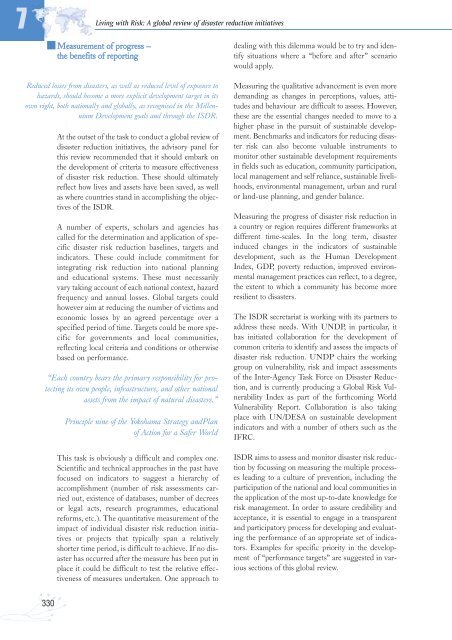A global review of disaster reduction initiatives - Welcome to the ...
A global review of disaster reduction initiatives - Welcome to the ...
A global review of disaster reduction initiatives - Welcome to the ...
Create successful ePaper yourself
Turn your PDF publications into a flip-book with our unique Google optimized e-Paper software.
7Living with Risk: A <strong>global</strong> <strong>review</strong> <strong>of</strong> <strong>disaster</strong> <strong>reduction</strong> <strong>initiatives</strong>Measurement <strong>of</strong> progress –<strong>the</strong> benefits <strong>of</strong> reportingReduced losses from <strong>disaster</strong>s, as well as reduced level <strong>of</strong> exposure <strong>to</strong>hazards, should become a more explicit development target in itsown right, both nationally and <strong>global</strong>ly, as recognised in <strong>the</strong> MillenniumDevelopment goals and through <strong>the</strong> ISDR.At <strong>the</strong> outset <strong>of</strong> <strong>the</strong> task <strong>to</strong> conduct a <strong>global</strong> <strong>review</strong> <strong>of</strong><strong>disaster</strong> <strong>reduction</strong> <strong>initiatives</strong>, <strong>the</strong> advisory panel forthis <strong>review</strong> recommended that it should embark on<strong>the</strong> development <strong>of</strong> criteria <strong>to</strong> measure effectiveness<strong>of</strong> <strong>disaster</strong> risk <strong>reduction</strong>. These should ultimatelyreflect how lives and assets have been saved, as wellas where countries stand in accomplishing <strong>the</strong> objectives<strong>of</strong> <strong>the</strong> ISDR.A number <strong>of</strong> experts, scholars and agencies hascalled for <strong>the</strong> determination and application <strong>of</strong> specific<strong>disaster</strong> risk <strong>reduction</strong> baselines, targets andindica<strong>to</strong>rs. These could include commitment forintegrating risk <strong>reduction</strong> in<strong>to</strong> national planningand educational systems. These must necessarilyvary taking account <strong>of</strong> each national context, hazardfrequency and annual losses. Global targets couldhowever aim at reducing <strong>the</strong> number <strong>of</strong> victims andeconomic losses by an agreed percentage over aspecified period <strong>of</strong> time. Targets could be more specificfor governments and local communities,reflecting local criteria and conditions or o<strong>the</strong>rwisebased on performance.“Each country bears <strong>the</strong> primary responsibility for protectingits own people, infrastructure, and o<strong>the</strong>r nationalassets from <strong>the</strong> impact <strong>of</strong> natural <strong>disaster</strong>s.”Principle nine <strong>of</strong> <strong>the</strong> Yokohama Strategy andPlan<strong>of</strong> Action for a Safer WorldThis task is obviously a difficult and complex one.Scientific and technical approaches in <strong>the</strong> past havefocused on indica<strong>to</strong>rs <strong>to</strong> suggest a hierarchy <strong>of</strong>accomplishment (number <strong>of</strong> risk assessments carriedout, existence <strong>of</strong> databases, number <strong>of</strong> decreesor legal acts, research programmes, educationalreforms, etc.). The quantitative measurement <strong>of</strong> <strong>the</strong>impact <strong>of</strong> individual <strong>disaster</strong> risk <strong>reduction</strong> <strong>initiatives</strong>or projects that typically span a relativelyshorter time period, is difficult <strong>to</strong> achieve. If no <strong>disaster</strong>has occurred after <strong>the</strong> measure has been put inplace it could be difficult <strong>to</strong> test <strong>the</strong> relative effectiveness<strong>of</strong> measures undertaken. One approach <strong>to</strong>dealing with this dilemma would be <strong>to</strong> try and identifysituations where a “before and after” scenariowould apply.Measuring <strong>the</strong> qualitative advancement is even moredemanding as changes in perceptions, values, attitudesand behaviour are difficult <strong>to</strong> assess. However,<strong>the</strong>se are <strong>the</strong> essential changes needed <strong>to</strong> move <strong>to</strong> ahigher phase in <strong>the</strong> pursuit <strong>of</strong> sustainable development.Benchmarks and indica<strong>to</strong>rs for reducing <strong>disaster</strong>risk can also become valuable instruments <strong>to</strong>moni<strong>to</strong>r o<strong>the</strong>r sustainable development requirementsin fields such as education, community participation,local management and self reliance, sustainable livelihoods,environmental management, urban and ruralor land-use planning, and gender balance.Measuring <strong>the</strong> progress <strong>of</strong> <strong>disaster</strong> risk <strong>reduction</strong> ina country or region requires different frameworks atdifferent time-scales. In <strong>the</strong> long term, <strong>disaster</strong>induced changes in <strong>the</strong> indica<strong>to</strong>rs <strong>of</strong> sustainabledevelopment, such as <strong>the</strong> Human DevelopmentIndex, GDP, poverty <strong>reduction</strong>, improved environmentalmanagement practices can reflect, <strong>to</strong> a degree,<strong>the</strong> extent <strong>to</strong> which a community has become moreresilient <strong>to</strong> <strong>disaster</strong>s.The ISDR secretariat is working with its partners <strong>to</strong>address <strong>the</strong>se needs. With UNDP, in particular, ithas initiated collaboration for <strong>the</strong> development <strong>of</strong>common criteria <strong>to</strong> identify and assess <strong>the</strong> impacts <strong>of</strong><strong>disaster</strong> risk <strong>reduction</strong>. UNDP chairs <strong>the</strong> workinggroup on vulnerability, risk and impact assessments<strong>of</strong> <strong>the</strong> Inter-Agency Task Force on Disaster Reduction,and is currently producing a Global Risk VulnerabilityIndex as part <strong>of</strong> <strong>the</strong> forthcoming WorldVulnerability Report. Collaboration is also takingplace with UN/DESA on sustainable developmentindica<strong>to</strong>rs and with a number <strong>of</strong> o<strong>the</strong>rs such as <strong>the</strong>IFRC.ISDR aims <strong>to</strong> assess and moni<strong>to</strong>r <strong>disaster</strong> risk <strong>reduction</strong>by focussing on measuring <strong>the</strong> multiple processesleading <strong>to</strong> a culture <strong>of</strong> prevention, including <strong>the</strong>participation <strong>of</strong> <strong>the</strong> national and local communities in<strong>the</strong> application <strong>of</strong> <strong>the</strong> most up-<strong>to</strong>-date knowledge forrisk management. In order <strong>to</strong> assure credibility andacceptance, it is essential <strong>to</strong> engage in a transparentand participa<strong>to</strong>ry process for developing and evaluating<strong>the</strong> performance <strong>of</strong> an appropriate set <strong>of</strong> indica<strong>to</strong>rs.Examples for specific priority in <strong>the</strong> development<strong>of</strong> “performance targets” are suggested in varioussections <strong>of</strong> this <strong>global</strong> <strong>review</strong>.330

















